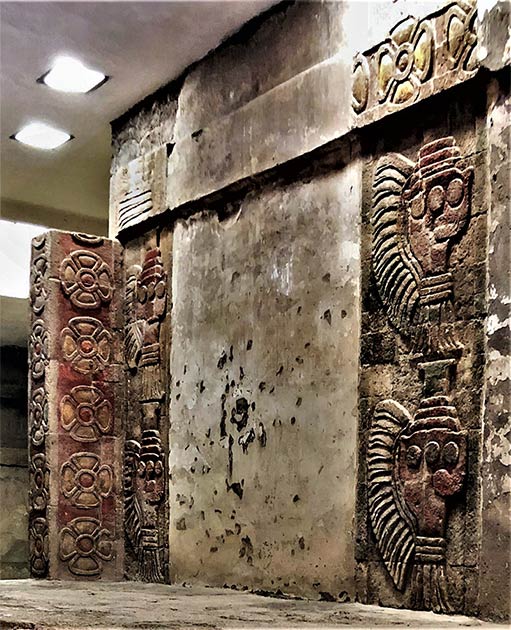
Mesoamerican Mural Minerals Reveal Secrets of Ancient City
In Mexico, researchers have for the first time ever discovered previously unknown Mesoamerican mural minerals. The mercury sulfate and iron oxide were found in wall paintings in one of the most important of all pre-Columbian cities, Teotihuacan. The Mesoamerican mural minerals find is helping experts to better understand how ancient Mesoamericans created their artworks and more about their beliefs.
An interdisciplinary team, that included specialists from the National Institute of Anthropology and History (INAH) and other Mexican research institutes, was involved in the study at the archaeological site, north-east of Mexico City. They carried out the chemical analysis of murals at the famous Quetzalpapálotl complex at Teotihuacan. The palace structure at the center of the complex is believed to have been inhabited by a high priest or a member of the ruling elite, because of its imposing remains and artworks. Some have speculated that it was a ceremonial complex. It is located not far from the famous Pyramid of the Moon.

A member of the INAH interdisciplinary team using specialized equipment to identify previously unknown Mesoamerican mural minerals on a wall painting in the Quetzalpapálotl complex. (Denisse Argote Espino / INAH)
Mesoamerican Mural Minerals Identified with High Technology
The research team employed the latest X-ray and electron microscopy equipment to analyze several mural paintings. These non-invasive technologies allowed them to analyze the chemicals used in the murals’ paints, without destroying any of the artwork. During their analysis the researchers made an important discovery. ‘For the first time, the use of cinnabar, a mercury sulfide’ was identified in the complex, according to the INAH. Traces of hematite, a rare iron oxide, were also found in the analysis. The minerals were found in wall paintings that date from between 200 and 350 AD during the peak of Teotihuacan’s influence.
It was also determined that the cinnabar and hematite had been applied directly to the murals. Cinnabar is famous for its reddish color. Heritage Daily reports that ‘Murals in Teotihuacan were often painted with the color red, believed to be associated with blood, life, fertility, and the rebirth of the Sun.’

The never seen before Mesoamerican mural minerals of cinnabar and hematite found in this early Teotihuacan mural. The distinctive reds on the left side of this image are especially noteworthy. Source: Denisse Argote Espino / INAH
Cinnabar and Hematite: Red Minerals of Wealth, Power, Magic
Fragments of cinnabar were found in representations of flowers and on seashells. Some cinnabar remains were also identified on an image of the Quetzalcoatl, the feathered-serpent God of Mesoamerican mythology. There was also evidence of hematite used on different images.
Cinnabar was not only used to achieve aesthetic effects in the paintings. Researchers are quoted by INAH as saying that ’This mineral was a symbol of wealth, power, and magical properties related to the gods of the underworld.’ This was because it was likened to blood, which had mystical qualities in ancient Mesoamerica. Specialists from the INAH stated that ‘Cinnabar’s high esteem lies not only in its rarity but also in the chemical characteristics of the pigment since the behavior of the color is similar to that of blood, which gives it a special connection.’
The never before identified minerals were found in the Temple of the Feathered Snails and the Quetzalpapálotl Palace. It would appear that the application of the reddish minerals cinnabar and hematite was for ceremonial and religious purposes. The INAH quotes the specialists as saying that the blood-red minerals were used ‘ to represent rituals, consolidate its religious structure and consecrate the spaces and the people who occupied them’.

In this image a researcher is analyzing the stucco of a wall in the Quetzalpapálotl complex which resulted in the identification of plaster, a material that had also never been identified before in Mesoamerica. (Denisse Argote Espino / INAH)
Other Artwork Material Finds Recently Found in Teotihuacan
The analysis of the murals also found evidence of gypsum and the use of plaster in the manufacture of the binder stucco. This was particularly the case on the Red Circles Platform in the Quetzalpapálotl complex.
It appears that gypsum was used in frescoes of a high quality that were not exposed to the elements. The INAH reports that the researchers believe that this demonstrates ‘ a change in stucco production technology, a topic that must be studied in more detail in future research.’
- Tamoanchan – In Search of the Lost Cradle of Mesoamerican Civilizations
- Danger on the Court: The Deadly Ancient Mesoamerican Ball Game
- Poisonous Pigments: History’s Deadliest Colors
The latest research is helping experts to solve some of the many mysteries that still surround Teotihuacan and its ancient culture. Teotihuacan was once the most populous urban center in Mesoamerica and an extremely important religious center. No one is sure if it was the capital of an empire, but it had immense cultural significance for later groups, including the Aztecs. It is best known now for some of the finest examples of step-pyramids in the Americas. No-one is sure what led to the abandonment of this city sometime in the 8 th century AD. However, the newly discovered Mesoamerican mural minerals and the technology used to identify them are providing researchers with better data to work with in their pursuit of unanswered questions.
Top image: The never seen before Mesoamerican mural minerals of cinnabar and hematite found in this early Teotihuacan mural. The distinctive reds on the left side of this image are especially noteworthy. Source: Denisse Argote Espino / INAH
By Ed Whelan















